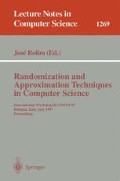Abstract
We study the average-case complexity of shortest paths problems in the vertex-potential model. The vertex-potential model is a family of probability distributions on complete directed graphs with arbitrary real edge lengths but without negative cycles. We show that on a graph with n vertices and with respect to this model, the single-source shortest-paths problem can be solved in O(n 2) expected time, and the all-pairs shortest-paths problem can be solved in O(n 2 log n) expected time.
Research supported by NSF grant CCR-9225008.
Research partially supported by ESPRIT LTR Project No. 20244 (ALCOM-IT).
Preview
Unable to display preview. Download preview PDF.
References
R. K. Ahuja, K. Mehlhorn, J. B. Orlin, and R. E. Tarjan, Faster algorithms for the shortest path problem, J. Assoc. Comput. Mach. 37 (1990) 213–223
R. Bellman, On a routing problem, Quart. Appl. Math. 16 (1958) 87–90
P. A. Bloniarz, A shortest-path algorithm with expected time O(n 2 log n log * n), SIAM J. Comput. 12 (1983) 588–600
B. V. Cherkassky, A. V. Goldberg, and T. Radzik, Shortest paths algorithms: Theory and experimental evaluation, Math. Programming 73 (1996) 129–174
B. V. Cherkassky, A. V. Goldberg, and C. Silverstein, Buckets, heaps, lists, and monotone priority queues, Proc. 8th Annual ACM-SIAM Symposium on Discrete Algorithms, New Orleans LA, 1997, 83–92
R. Davis and A. Prieditis, The expected length of a shortest path, Inform. Process. Lett. 46 (1993) 135–141
E. W. Dijkstra, A note on two problems in connexion with graphs, Numer. Math. 1 (1959) 269–271
J. Edmonds and R. M. Karp, Theoretical improvements in algorithmic efficiency for network flow problems, J. Assoc. Comput. Mach. 19 (1972) 248–264
L. R. Ford, Jr. and D. R. Fulkerson, Flows in Networks, Princeton University Press, Princeton NJ, 1962
M. L. Fredman and R. E. Tarjan, Fibonacci heaps and their uses in improved network optimization algorithms, J. Assoc. Comput. Mach. 34 (1987) 596–615
A. M. Frieze and G. R. Grimmett, The shortest-path problem for graphs with random arc-lengths, Discrete Appl. Math. 10 (1985) 57–77
A. V. Goldberg, Scaling algorithms for the shortest paths problem, SIAM J. Comput. 24 (1995) 494–504
T. Hagerup and C. Rüb, A guided tour of Chernoff bounds, Inform. Process. Lett. 33 (1989/90) 305–308
R. Hassin and E. Zemel, On shortest paths in graphs with random weights, Math. Oper. Res. 10 (1985) 557–564
W. Hoeffding, Probability inequalities for sums of bounded random variables, J. Amer. Statist. Assoc. 58 (1963) 13–30
D. B. Johnson, Efficient algorithms for shortest paths in sparse networks, J. Assoc. Comput. Mach. 24 (1977) 1–13
D. R. Karger, D. Koller, and S. J. Phillips, Finding the hidden path: Time bounds for all-pairs shortest paths, SIAM J. Comput. 22 (1993) 1199–1217
S. G. Kolliopoulos and C. Stein, Finding real-valued single-source shortest paths in o(n 3) expected time, in: W. H. Cunningham, S. T. McCormick, and M. Queyranne (Eds.), Integer Programming and Combinatorial Optimization (Lecture Notes in Computer Science; 1084), Springer-Verlag, Berlin, 1996, 94–104
C. C. McGeoch, All-pairs shortest paths and the essential subgraph, Algorithmica 13 (1995) 426–441
K. Mehlhorn and V. Priebe, On the all-pairs shortest-path algorithm of Moffat and Takaoka, Random Structures Algorithms 10 (1997) 205–220
A. Moffat and T. Takaoka, An all pairs shortest path algorithm with expected time O(n 2 log n), SIAM J. Comput. 16 (1987) 1023–1031
K. Noshita, A theorem on the expected complexity of Dijkstra's shortest path algorithm, J. Algorithms 6 (1985) 400–408
P. M. Spira, A new algorithm for finding all shortest paths in a graph of positive arcs in average time O(n 2 log2 n), SIAM J. Comput. 2 (1973) 28–32
Author information
Authors and Affiliations
Editor information
Rights and permissions
Copyright information
© 1997 Springer-Verlag Berlin Heidelberg
About this paper
Cite this paper
Cooper, C., Frieze, A., Mehlhorn, K., Priebe, V. (1997). Average-case complexity of shortest-paths problems in the vertex-potential model. In: Rolim, J. (eds) Randomization and Approximation Techniques in Computer Science. RANDOM 1997. Lecture Notes in Computer Science, vol 1269. Springer, Berlin, Heidelberg. https://doi.org/10.1007/3-540-63248-4_2
Download citation
DOI: https://doi.org/10.1007/3-540-63248-4_2
Published:
Publisher Name: Springer, Berlin, Heidelberg
Print ISBN: 978-3-540-63248-1
Online ISBN: 978-3-540-69247-8
eBook Packages: Springer Book Archive

